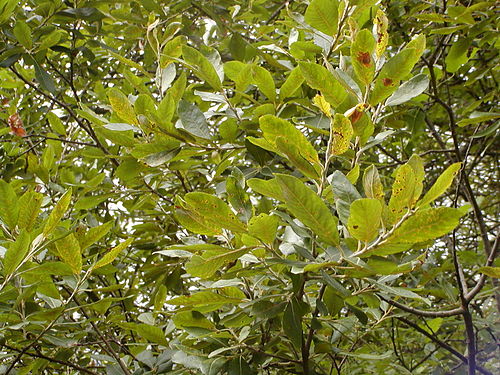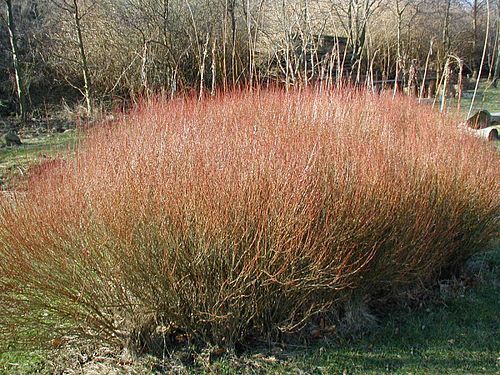Purple Willow
| Habit | tree
| |
|---|---|---|
| Height: | ⇕ | 15 ft"ft" can not be assigned to a declared number type with value 15. |
| Width: | ⇔ | 15 ft"ft" can not be assigned to a declared number type with value 15. |
| Lifespan: | ⌛ | perennial |
| Bloom: | ❀ | early spring, mid spring, late spring |
| Exposure: | ☼ | sun |
|---|---|---|
| Water: | ◍ | wet, moist |
| Features: | ✓ | flowers |
| USDA Zones: | 5 to 10 | |
| Flower features: | ❀ | red, pink |
|
Salix > |
purpurea > |
L. > |
Salix purpurea (Purple Willow or Purple Osier) is a species of willow native to most of Europe and western Asia north to the British Isles, Poland, and the Baltic States.[1][2][3]
It is a deciduous shrub growing to 1-3 m (rarely to 5 m) tall, with purple-brown to yellow-brown shoots, turning pale grey on old stems. The leaves are 2-8 cm (rarely to 12 cm) long and 0.3-1 cm (rarely 2 cm) wide; they are dark green above, glaucous green below, and unusually for a willow, are often arranged in opposite pairs rather than alternate. The flowers are small catkins 1.5-4.5 cm long, produced in early spring; they are often purple or red in colour, whence the name of the species (other willows mostly have whitish, yellow or green catkins).[2][3]
Read about Purple Willow in the Standard Cyclopedia of Horticulture
|
|---|
|
Salix purpurea. (S. Forbyana, Smith. Vetrix purpurea, Rafin.). Purple Osier. A shrub or small tree, spreading at base, with long, flexible branches: lvs. oblanceolate, serrulate, glabrous, veiny, 3-6 in. long, often appearing opposite: aments sessile, slender; pistillate recurved; scales purple; stamen 1: caps. small, ovate. Eu.—Planted as an ornamental shrub and escaped in many places. Also grown as a basket-willow. Var. pendula, Dipp. (S. nigra pendula, Hort. S. Americana pendula, Hort.). Branches pendent. Var. lambertiana, W. D. Koch. Lvs. broader, generally obovate-lanceolate, more abruptly acuminate, usually more rounded at the base, up to 4 in. long and 3/4 in. broad. Var. sericea, W. D. Koch. Lvs. silky when young, becoming glabrous. Here belongs the "Kecks Willow" (var. Kecksii, Hort.). Var. amplexicaulis, Boiss. Lvs. sessile or subsessile, cordate or rounded at the base, acuminate, oblong to oblong-lanceolate, glabrous.
|
Cultivation
Propagation
Pests and diseases
Varieties
Gallery
References
- Standard Cyclopedia of Horticulture, by L. H. Bailey, MacMillan Co., 1963
External links
- w:Purple Willow. Some of the material on this page may be from Wikipedia, under the Creative Commons license.
- Purple Willow QR Code (Size 50, 100, 200, 500)




